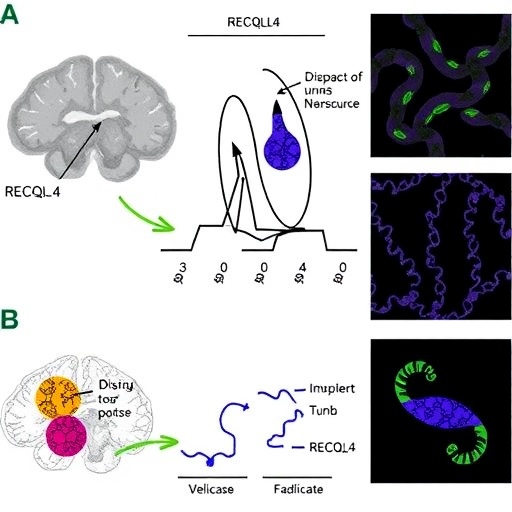In the relentless battle against glioblastoma, one of the most aggressive and treatment-resistant brain tumors, researchers have uncovered critical insights into the molecular machinery that determines how glioma cells respond to chemotherapy. A recent study published in BMC Cancer reveals the nuanced and distinct roles of two RecQ helicases, RECQL4 and BLM, whose functions influence glioma cell fate following chemotherapeutic stress. This investigation deepens our understanding of tumor biology and highlights promising avenues for targeted therapies.
DNA helicases are vital enzymes responsible for unwinding DNA strands, a necessary process during replication, repair, and recombination. Within human cells, the RecQ family of helicases plays a pivotal role in maintaining genome stability, a factor critical in preventing cancer development. Among these, RECQL4 and BLM stand out due to their involvement in DNA replication stress responses and DNA damage repair pathways. Prior studies have established the overexpression of these helicases in glioblastoma, yet the differential contributions of RECQL4 and BLM to chemotherapy resistance had remained unclear until now.
Glioblastoma’s notorious resistance to conventional therapies such as temozolomide (TMZ), a standard alkylating agent, and newer treatments involving PARP inhibitors like olaparib (OLA), poses significant treatment challenges. Previous research showed that BLM depletion in glioma cells results in senescence-associated or polyploid phenotypic shifts when exposed to TMZ and OLA. However, the specific effects of RECQL4 depletion under similar conditions were largely uncharted territory, prompting the authors to explore how RECQL4 influences glioma cellular responses to chemotherapeutics.
To investigate this, the researchers engineered glioma cell lines with knocked-out RECQL4 (RQ4 KO) and compared them to those lacking BLM expression (BLM KO). Using LN18 and LN229 glioma cells, comprehensive analyses were conducted focusing on cell viability, apoptosis induction, senescence markers, polyploidization, and changes in cell cycle dynamics. High-throughput transcriptomic profiling was also performed to elucidate the global gene expression alterations resulting from depletion of either helicase.
Interestingly, unlike BLM deletion, which led to distinct phenotypic outcomes, RECQL4 depletion elicited profound changes in the transcriptome that were largely unique and non-overlapping with those observed in BLM-deficient cells. This divergence even influenced how these cells responded to chemotherapeutic agents. While both RQ4 KO and BLM KO cells demonstrated only modest effects on baseline proliferation and viability, RECQL4-deficient glioma cells showed heightened sensitivity to combined TMZ and OLA treatment, exhibiting marked decreases in survival coupled with elevated apoptotic activity.
Contrary to BLM-depleted cells, which underwent senescence or polyploidy upon drug exposure, the RECQL4 knockout cells resisted such phenotypic shifts. Instead, these cells experienced cell cycle arrest without entering senescence or exhibiting polyploid nuclei, highlighting a mechanistic dichotomy in how these helicases modulate cell fate under chemotherapy-induced stress. This distinction may inform more precise strategies to exploit helicase function for therapeutic gain.
Another unexpected finding was the relative resistance of both RQ4 KO and BLM KO cells to WP744, a novel doxorubicin derivative with potent anti-tumor activity. This resistance contrasted with the wild-type LN229 glioma cells’ sensitivity and suggests that RECQL4 and BLM may also influence responses to certain anthracycline-based agents, adding a layer of complexity to treatment design and drug development.
The implications of these findings are profound. They underscore the non-redundant roles of RECQL4 and BLM helicases in managing DNA repair and cell cycle progression upon chemotherapy, thereby shaping therapeutic outcomes in glioblastoma. Targeting RECQL4, in particular, emerges as a compelling option to augment the efficacy of existing chemotherapeutic regimens, potentially overcoming resistance mechanisms that have stymied progress in treating this fatal cancer.
This study also opens the door for future exploration into the molecular pathways downstream of RECQL4 and BLM activity. Understanding how these helicases interact with other DNA repair proteins, signaling cascades, and cellular checkpoints could reveal novel targets and biomarkers predictive of treatment response. Moreover, discerning their roles across different glioma subtypes and patient-derived models will be crucial for translating these insights into clinical practice.
RECQL4’s unique transcriptomic footprint observed here may reveal vulnerabilities in glioma cells that can be exploited therapeutically. For example, drugs that mimic RECQL4 depletion or inhibit its helicase activity might synergize with TMZ and PARP inhibitors, enhancing tumor cell kill while sparing normal tissues. However, given the ubiquitous necessity of RecQ helicases for genome integrity in normal cells, therapeutic approaches must be carefully tailored to minimize collateral damage.
Overall, this study exemplifies the growing recognition that effectively tackling glioblastoma requires detailed knowledge of the molecular underpinnings of chemoresistance. By disentangling the distinct molecular roles of helicases like RECQL4 and BLM, researchers pave the way for innovative strategies that could finally improve outcomes for patients suffering from this devastating disease.
The challenge remains formidable, yet the new data presented by Wojnicki and colleagues provide hope and direction. As research continues to uncover the intricate dance between tumor genetics and treatment response, personalized therapeutic regimens leveraging helicase targeting may become an integral part of glioblastoma management in the near future.
In conclusion, the complex interplay between RECQL4 and BLM helicases represents a frontier in cancer biology that bridges DNA repair dynamics with chemotherapeutic efficacy. This latest work urges oncologists and molecular biologists alike to consider these enzymes as both biomarkers and therapeutic targets in the ongoing quest to outmaneuver glioblastoma.
Subject of Research:
The study focuses on the differential and shared functions of RECQL4 and BLM helicases in DNA damage response pathways, particularly in how their depletion affects glioma cell survival, apoptosis, senescence, and drug resistance following chemotherapy exposure.
Article Title:
Shared and non-overlapping functions of RECQL4 and BLM helicases in chemotherapeutics-induced glioma cell responses
Article References:
Wojnicki, K., Wojtas, B., Ciechomska, I.A. et al. Shared and non-overlapping functions of RECQL4 and BLM helicases in chemotherapeutics-induced glioma cell responses. BMC Cancer 25, 1434 (2025). https://doi.org/10.1186/s12885-025-14932-0
Image Credits: Scienmag.com




